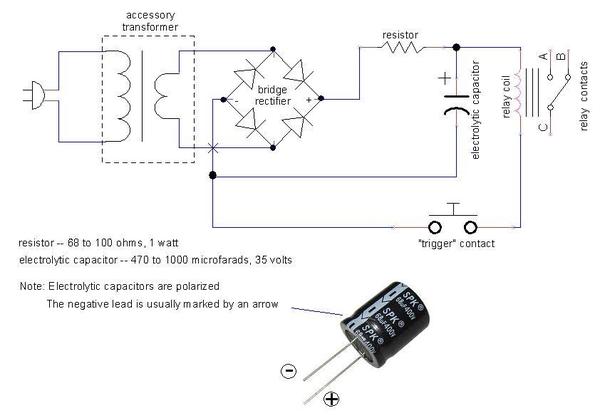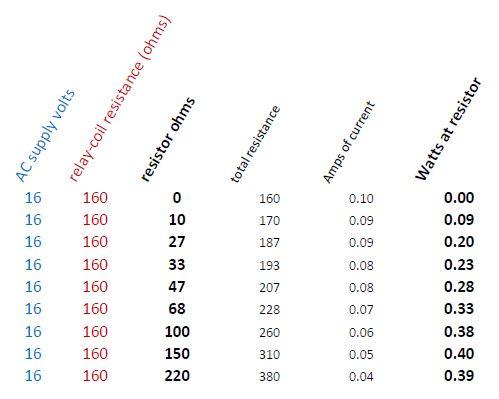Last time I posted, I was trying to wire a block signal. Well I was successful and I have wired another since. I decided to go with a rectifier bridge just to see it work that way. However I forgot to put a capacitor in with the rectifier so I'm getting relay chatter. I going to fix that, but I need to know what type of capacitor do I need.
Replies sorted oldest to newest
Denny,
I would try using an electrolytic capacitor in the range of 470 to 1000 microfarads (available at Radio Shack). Electrolytic capacitors are polarized; so be careful to connect the positive lead to the positive side of the bridge rectifier's output. (If an electrolytic capacitor is connected backwards, it will blow up and spit out electrolyte everywhere.)
The attached diagram shows the connections.
/Ralph Platz
Attachments
One change to the circuit below I'd recommend, put the filter cap positive connection on the other side of the dropping resistor. That way it stores a high voltage charge (more energy) and will do a better job filtering.
Attachments
One change to the circuit below I'd recommend, put the filter cap positive connection on the other side of the dropping resistor. That way it stores a high voltage charge (more energy) and will do a better job filtering.
I would not make this change; I would stick with the original diagram. When no "triggering" contact is being made, the capacitor will charge up (through the resistor) to the full voltage of the supply (i.e. to 1.4 x the AC rms voltage). Then, when a "triggering" contact is made, the full charge on the capacitor will be dumped into the relay, giving it a strong kick-start. Subsequent current through the resistor will hold the relay closed, but the now-lesser current will also lower the heating of the relay coil.
/Ralph Platz
When used with the insulated rail method,an added resistor will alleviate sparking on the train wheels. The resistor would go in series to one of the capacitor leads,not the way drawn in the diagram. Using larger capacitors may have this problem. I leave this out of my diagrams because people complain they are too complicated already. Most any small resistor 10 ohms or more will work to eliminate sparking.
Dale H
Believe it of not, I actually understand what you guys are saying. I'm heading to Radio Shack in a littler while. I'll let you know how that worked out. My next project is crossing gates. I only have one crossing, but who knows, I might pull it all up and reconfigure my layout.
Ralph, I have the capacitor. The question I have for you is, the shorter contact is the negative side correct? Second, I was only able to get 0.5w resistors. So if I run two of them parallel, it will equal 1w?
Ralph, I have the capacitor. The question I have for you is, the shorter contact is the negative side correct? Second, I was only able to get 0.5w resistors. So if I run two of them parallel, it will equal 1w?
Usually but not always. The minus is usually marked on the side by the terminal end.
2 equal .5 watt resistors in parallel are 1 watt and will have half the resistance. 2, 100 ohm ones for example in parallel are 50 ohms
2 equal .5 watt resistors in series will be 1 watt at double the resistance. 2, 100 ohm ones in series would act like 200 ohms in the circuit.
Dale H
Ralph, I have the capacitor. The question I have for you is, the shorter contact is the negative side correct? Second, I was only able to get 0.5w resistors. So if I run two of them parallel, it will equal 1w?
The wattage rating on a resistor indicates how much heat the resistor can reasonably withstand when steady-state current flows through it.
The heat (expressed in watts) which is generated in a resistor can be calculated in either of two ways:
- Watts = volts x amps
↔ the volts seen across the resistor itself times the current (in amps) flowing through the resistor, or - Watts = amps2 x ohms
↔ the square of the current (in amps) flowing through the resistor times the ohms of the resistor.
For now, however, I will assume the following:
- The AC voltage which you are applying to the bridge rectifier is 16 volts.
- The resistance of your relay's coil is 160 ohms.
If your applied AC voltage is higher than 16 volts, or if your relay-coil's resistance is lower than 160 ohms, then the calculations in the table need to be redone.
If you have a multimeter, try to read the resistance in ohms of your relay's coil, and let us know what you find..
/Ralph
Attachments
Okay, I will try to get a ohm reading off the relay coil. I'm using my CW-80 accessory terminals to power the relay. I haven't had a chance to get down to the man cave to do anything (the honey do list isn't done yet), but I'm going to try and make time tomorrow. The color bands on the resistors tells what ohm it is so I'll let you know that too. If I haven't mentioned this before, I really appreciate your guidance.
I am a bit puzzled about what you are trying to do. You need to know the input voltage,which is The AC voltage times 1.41 if a DC relay is used with a bridge and capacitor. Then you need to know the relay coil voltage. So for 16 VAC that would be 22.4 so a 24VDC coil would work fine. No resistor would be needed except in series with the capacitor to reduce wheel arcing. If using a 12VDC coil with the above input voltage use a resistor in series of about 80% of the relay coil resistance. Half watt is fine. Most model train type relays at most use 1 watt of power. The ones I use are DPDT 15 amp ones with 480 ohm,12VDC coils. These use about .33 watts of power each. I use about 200 of them on the layout so they consume about 70 watts if they are all powered up.
Dale H
Okay, I will try to get a ohm reading off the relay coil. I'm using my CW-80 accessory terminals to power the relay. I haven't had a chance to get down to the man cave to do anything (the honey do list isn't done yet), but I'm going to try and make time tomorrow. The color bands on the resistors tells what ohm it is so I'll let you know that too. If I haven't mentioned this before, I really appreciate your guidance.
As Dale H. mentions below, it would be helpful also to know the manufacturer's nominal voltage rating for the relay coil.
I am a bit puzzled about what you are trying to do. You need to know the input voltage,which is The AC voltage times 1.41 if a DC relay is used with a bridge and capacitor. Then you need to know the relay coil voltage. So for 16 VAC that would be 22.4 so a 24VDC coil would work fine. No resistor would be needed except in series with the capacitor to reduce wheel arcing. If using a 12VDC coil with the above input voltage use a resistor in series of about 80% of the relay coil resistance. Half watt is fine. Most model train type relays at most use 1 watt of power. The ones I use are DPDT 15 amp ones with 480 ohm,12VDC coils. These use about .33 watts of power each. I use about 200 of them on the layout so they consume about 70 watts if they are all powered up.
Dale H
Dale,
You make some good points here.
If we know the relay's nominal voltage rating, and if we know the relay coil's resistance, we can calculate the rest.
If the electrolytic capacitor is separated from the bridge rectifier by the resistor, then the capacitor's voltage will rise to the AC peak (i.e. 1.4 times RMS) when no current is flowing through the relay coil. But when current flows through the relay coil, the capacitor may discharge faster than it can be recharged through the resistor; in that case the DC will be pulsating at the AC cycle-rate, and its effective voltage will be close to the AC RMS.
If the relay is rated at "12 VDC", and if the relay coil has a resistance of 480 ohms, then ½-watt resistors are adequate — 150 ohms if the voltage which the relay sees is effectively the RMS of the 16 VAC, or 480 ohms if the relay really sees continuously the peak of the AC voltage.
/Ralph
Attachments
Nice chart Ralph
The only other thing I can say is that you do not have to get that accurate. Relay coils have a lot of voltage tolerance. The 12VDC ones I have will take up to 18 volts continuous without damage. To run my relay system I use a 18 VAC Lionel brick. With a bridge and capacitor the output is around 24 volts DC,perfect supply for relays and timers,and I use a lot of them. I wire the 12VDC ones in series of 2,so I really use them as 4PDT ones. This gives me room for relay logic and switching multiple circuits when needed. If I want to use them singly I put them in series with a 390 ohm resistor or use a 24VDC coil one.
Dale H
WOW! I am going to print this thread out for future reference. This is going to come in very handy in the future. Thanks to everyone that posted their help.
I really like this thread. A perfect tutorial in easy to understand language and lots of good illustrations.
Thanks Everyone!
Cheers
Hey everybody,
I just want to let you know that the relay chatter issue is over. Your advice worked out great.
My next project is expanding my table. My main table is 6'x8'. Then I added a 4'x5' addition so it looks like a 'L'. That's where my train yard is. I'm going to add another 3'x4' section to the 4'x5' to make the yard longer.












